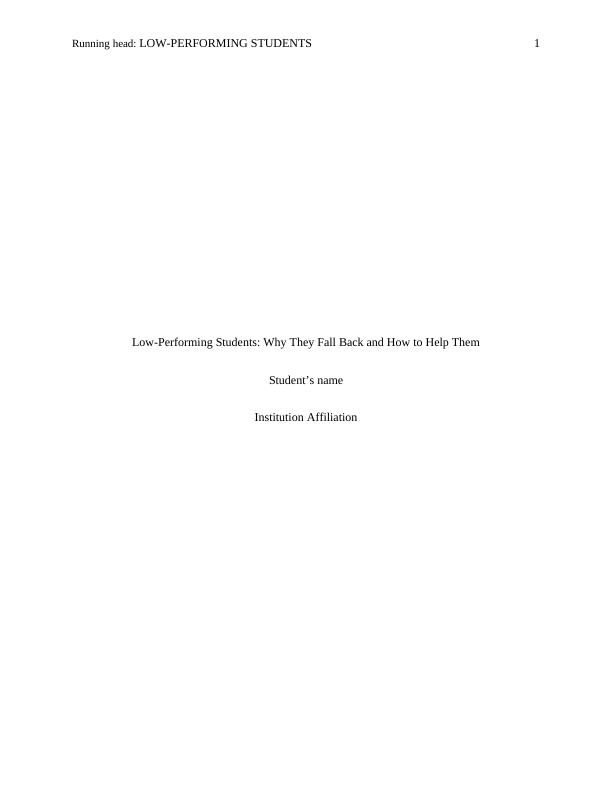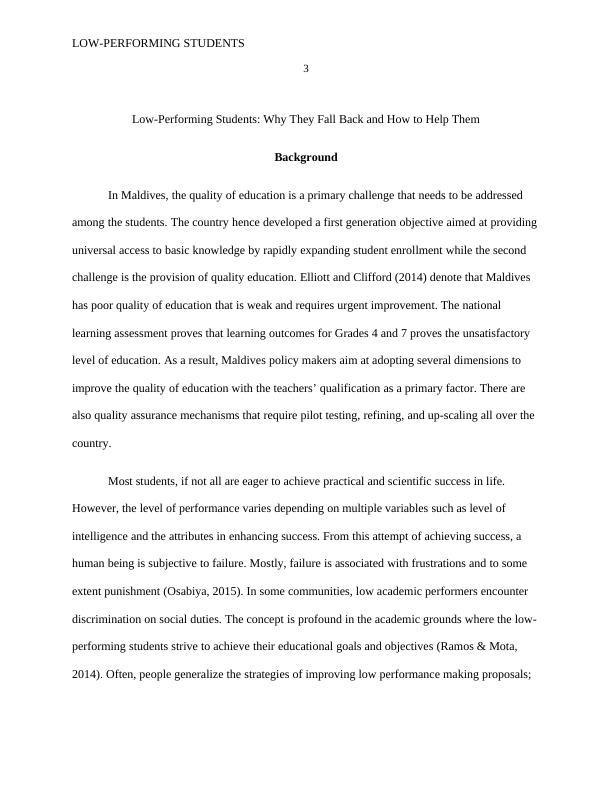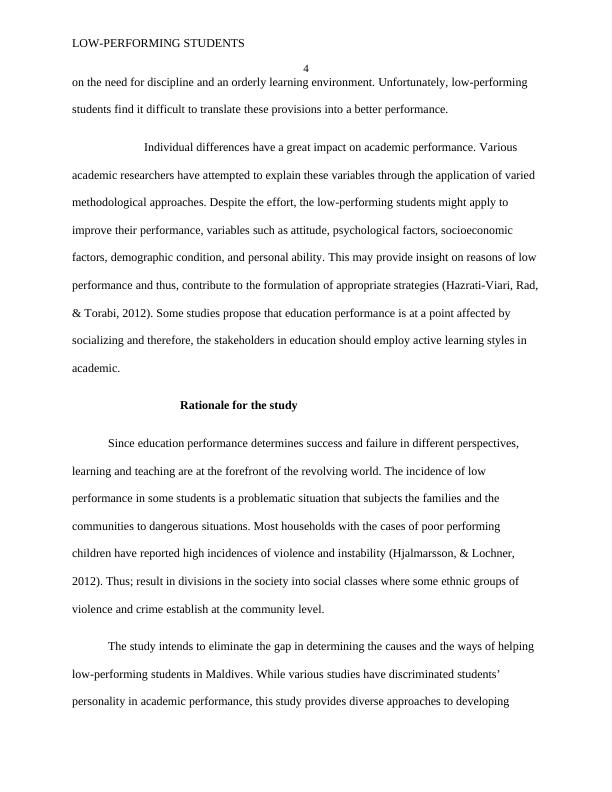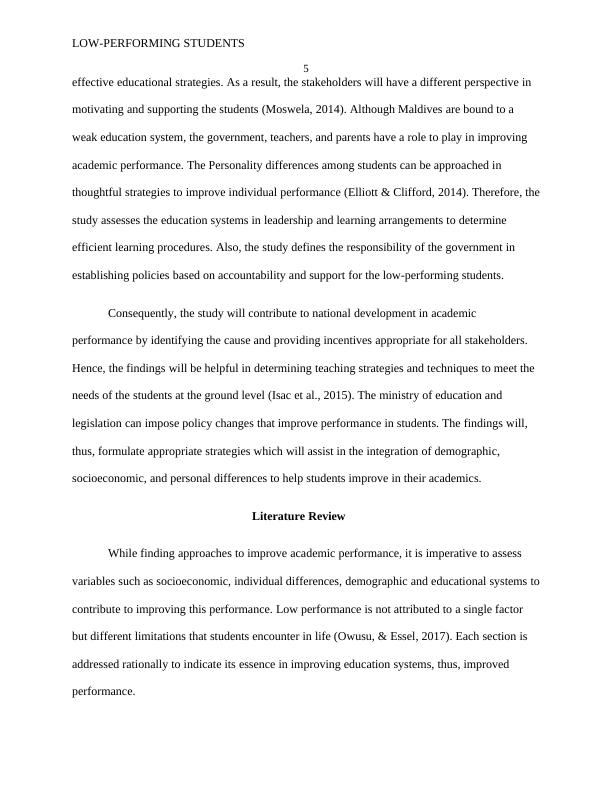Ask a question from expert
Low-Performing Students (Doc)
27 Pages4401 Words242 Views
Added on 2020-03-15
Low-Performing Students (Doc)
Added on 2020-03-15
BookmarkShareRelated Documents
Running head: LOW-PERFORMING STUDENTS1Low-Performing Students: Why They Fall Back and How to Help ThemStudent’s nameInstitution Affiliation

LOW-PERFORMING STUDENTS 2AbstractRaising the performance of low-performing students is among the prioritized plans in Maldives. As a result, various programs are focusing on explaining variables in raising the academic standards for this group. Poor performance in school has an adverse effect both at individual and societal level (Banerjee, 2016). The effort of defining the cause and strategizing on effective improvement strategies is a goal to improve overall education performance in Maldives. Also, the incentive will help develop skills which impact positively on the national economy. Identifying the problematic situations and integrating various institutions is the best approach to improving performance in academics. This paper, therefore, reviews various literatures with respect to the issue, presents data collection strategies relevant to the study and develops findingsbasing on the reviewed literature and data analysis.

LOW-PERFORMING STUDENTS 3Low-Performing Students: Why They Fall Back and How to Help ThemBackgroundIn Maldives, the quality of education is a primary challenge that needs to be addressed among the students. The country hence developed a first generation objective aimed at providinguniversal access to basic knowledge by rapidly expanding student enrollment while the second challenge is the provision of quality education. Elliott and Clifford (2014) denote that Maldives has poor quality of education that is weak and requires urgent improvement. The national learning assessment proves that learning outcomes for Grades 4 and 7 proves the unsatisfactory level of education. As a result, Maldives policy makers aim at adopting several dimensions to improve the quality of education with the teachers’ qualification as a primary factor. There are also quality assurance mechanisms that require pilot testing, refining, and up-scaling all over the country.Most students, if not all are eager to achieve practical and scientific success in life. However, the level of performance varies depending on multiple variables such as level of intelligence and the attributes in enhancing success. From this attempt of achieving success, a human being is subjective to failure. Mostly, failure is associated with frustrations and to some extent punishment (Osabiya, 2015). In some communities, low academic performers encounter discrimination on social duties. The concept is profound in the academic grounds where the low-performing students strive to achieve their educational goals and objectives (Ramos & Mota, 2014). Often, people generalize the strategies of improving low performance making proposals;

LOW-PERFORMING STUDENTS 4on the need for discipline and an orderly learning environment. Unfortunately, low-performing students find it difficult to translate these provisions into a better performance.Individual differences have a great impact on academic performance. Various academic researchers have attempted to explain these variables through the application of varied methodological approaches. Despite the effort, the low-performing students might apply to improve their performance, variables such as attitude, psychological factors, socioeconomic factors, demographic condition, and personal ability. This may provide insight on reasons of low performance and thus, contribute to the formulation of appropriate strategies (Hazrati-Viari, Rad,& Torabi, 2012). Some studies propose that education performance is at a point affected by socializing and therefore, the stakeholders in education should employ active learning styles in academic.Rationale for the studySince education performance determines success and failure in different perspectives, learning and teaching are at the forefront of the revolving world. The incidence of low performance in some students is a problematic situation that subjects the families and the communities to dangerous situations. Most households with the cases of poor performing children have reported high incidences of violence and instability (Hjalmarsson, & Lochner, 2012). Thus; result in divisions in the society into social classes where some ethnic groups of violence and crime establish at the community level.The study intends to eliminate the gap in determining the causes and the ways of helping low-performing students in Maldives. While various studies have discriminated students’ personality in academic performance, this study provides diverse approaches to developing

LOW-PERFORMING STUDENTS 5effective educational strategies. As a result, the stakeholders will have a different perspective in motivating and supporting the students (Moswela, 2014). Although Maldives are bound to a weak education system, the government, teachers, and parents have a role to play in improving academic performance. The Personality differences among students can be approached in thoughtful strategies to improve individual performance (Elliott & Clifford, 2014). Therefore, thestudy assesses the education systems in leadership and learning arrangements to determine efficient learning procedures. Also, the study defines the responsibility of the government in establishing policies based on accountability and support for the low-performing students. Consequently, the study will contribute to national development in academic performance by identifying the cause and providing incentives appropriate for all stakeholders. Hence, the findings will be helpful in determining teaching strategies and techniques to meet the needs of the students at the ground level (Isac et al., 2015). The ministry of education and legislation can impose policy changes that improve performance in students. The findings will, thus, formulate appropriate strategies which will assist in the integration of demographic, socioeconomic, and personal differences to help students improve in their academics.Literature ReviewWhile finding approaches to improve academic performance, it is imperative to assess variables such as socioeconomic, individual differences, demographic and educational systems tocontribute to improving this performance. Low performance is not attributed to a single factor but different limitations that students encounter in life (Owusu, & Essel, 2017). Each section is addressed rationally to indicate its essence in improving education systems, thus, improved performance.

LOW-PERFORMING STUDENTS 6Before analyzing factors affecting performance in Maldives, it is vital to consider the statistical reports on students’ enrollment and performance in different academic levels. According to the World Bank statistics, the completion rate in primary education is high with 114% in 2010 which is higher than in the developing countries. However, the attainment rate at the lower secondary levels raises a concern about the quality of education since only 27% achieved a passing grade in 2008 (Bank, 2017). The problem advanced in 2011 when the figures decreased to 16%. Also, the incidences of school dropout have gradually increased.Demographic ApproachMaldives consists of 1,192 islands which hold a population of 36000 square people. The economists classified the country as a middle-income nation (Kundur, 2012). However, the resultof this data does not satisfy the translation of the economic development to benefit children in anequal way. 40% of the entire population in Maldives is made of children between the ages of (0-4) years. One possible reason for this demographic result could be the emigration of the adults to further higher-quality education (Bank, 2017). The results also suggest possibilities of high dependency ratio in the future. After the economic crisis in 2009 the economic growth of the nation increased, but with significant inequalities in the regions (May, 2016). The trend of decreased poverty level depends on one's location; poverty increased in the capital and reduced in the atolls. For this reason, the access to education is also affected. Socio-Economic FactorsNotably, socioeconomic disadvantages contribute to the low performance of students in alarger scope. The current research indicates that low performance in students prevails in an individual with the higher socioeconomically disadvantages. These students have poor language

End of preview
Want to access all the pages? Upload your documents or become a member.
Related Documents
Impact of Strategic Leadership Case Study 2022lg...
|41
|12482
|28
Parent Involvement: Importance, Perceptions, and Advantageslg...
|9
|2151
|61
Leadership for the Contemporary Organizations.lg...
|4
|467
|29
Academic Integrity: Importance, Implications, and Skills Learnedlg...
|10
|2417
|364
Impact of Motivation on Student’s Communicationlg...
|9
|2547
|75
Study Skills for Higher Educationlg...
|7
|1292
|51